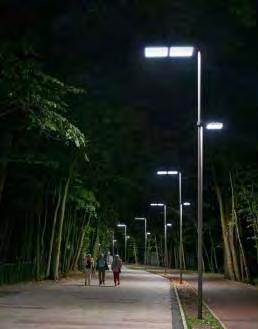
1 minute read
3.17 Street and Open Space Lighting Strategy
The approach to lighting will support the protection and expansion of the existing wildlife corridors, as well as providing lighting to the development and illuminated new path networks that feel safe and secure.

Advertisement
Lighting and passive surveillance from new homes helps people feel safe when moving around, especially at night, but it may also impact wildlife if the light is too bright. Warmer colour temperatures (2200 to 2700 kelvin) have been shown to reduce the impact on nocturnal wildlife activity and this is the approach that would be advocated for Ladyfield.
New lighting will incorporate smart technologies, to direct light where it is needed and programmed to reduce in its intensity during times of less frequent use at night. Along with supporting night-time wildlife activities, the lighting strategy will also service active travel routes and quality open spaces around new homes which are accessible and safe once it is dark.
Lighting should be dementia-friendly, providing an even and consistent spread of light which avoids casting shadows. Over-head lighting is preferred as it can be controlled to focus on paths and open spaces, pointing downwards to reduce glare.
Bollard lighting should be avoided as it is visually leaky, with light being at around face-height for some adapted bicycles, and in the vision of people using wheelchairs or other similar mobility aids.
The Crichton is used by local residents as an open and safe resource to exercise in the evenings; Ladyfield should be an extension of this and provide a comfortable and attractive environment at all times of the day. Well-lit links to The Crichton should be made along existing east-west routes.
Main path routes should be over-looked by new homes, which creates a visual link between indoor and outdoor use, helping people feel safer in their homes and in their external environment.






